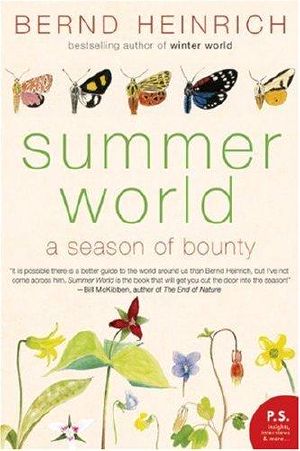Summer World · a Season of Bounty

- Authors
- Heinrich, Bernd
- Publisher
- HarperCollins
- Tags
- nature , seasons , wildlife , animals - summering , life sciences , animals , science , summer , plants , animal behavior , summer - new england , ecology , adaptation (biology) , animal-plant relationships , animals - habitations , essays , general
- ISBN
- 9780061867873
- Date
- 2010-03-24T01:21:05+00:00
- Size
- 4.15 MB
- Lang
- en
Amazon.com ReviewBook Description
In Summer World: A Season of Bounty, Bernd Heinrich brings us the same bottomless reserve of wonder and reverence for the teeming animal life of backwoods New England that he brought us in Winter World: The Ingenuity of Animal Survival. Now he is focusing on the animal kingdom in the extremes of the warmer months, with all its feeding, nesting, fighting, and mating.
Whether presenting disquisitions on ant wars, the predatory characteristics of wasps, the mating rituals of woodpeckers, or describing an encounter with a road full of wood frogs, Summer World never stops observing the beautifully complex interactions of animals and plants with nature, giving extraordinary depth to the relationships between habitat and the warming of the earth. How can cicadas survive—and thrive—at temperatures pushing 115°F? Do hummingbirds know what they're up against before they migrate over the Gulf of Mexico? Why do some trees stop growing taller even when three months of warm weather remain? With awe and unmatched expertise, Heinrich explores hundreds of questions like these.
Exquisitely illustrated with dozens of the author's own drawings, Summer World is Bernd Heinrich's most engaging book to date, a fascinating work from one of our very best science writers.
On Summer World: An Amazon Exclusive Essay by Bernd Heinrich
Summer, as I experience it, is not just one time. In terms of living, it is a time of courting, birthing, foraging and feeding, avoiding being eaten, growing, and lastly preparing for winter. Furthermore, unlike in winter or life under severe desert conditions, nothing is static. Most of us live in a world where timing is everything. Here in Vermont and Maine where I live, there is about a week to prepare the soil, another to plant the peas, another to put in the tomato plants. There is a week where the bees pollinate the apple trees and a week for us to harvest the fruit, and another to dig the potatoes. All nature is on a tight schedule. The wood frogs mate in mid-April, the robins return late April, the blueberries bloom in May, and the geese migrate north the second week in October. Summer as we know it is not a uniform struggle against excessive heat and lack of water. It is instead a continually shifting schedule of living where the lives of one species adjust to those of others.
So, as I set out to write Summer World, my focus changed. One potential approach was to discuss various topics such as mating, nesting, feeding and predator avoidance. Instead, it seemed possibly more engaging to concentrate on conspicuous aspects of the lives of common, every-day animals and plants that we tend to take for granted but that are marvelous because of their hidden agendas and concealed complexities.
It seems to me that we are in a perpetual crisis mode where attention is rightly focused on what is wrong with the world, although too little appreciation is given to what is right with it. Nature is always right. It always bats last; it is the final arbiter of all things that concern every living thing. So I focused on the first thing I saw that captured my attention: mating wood frogs. This species breeds in large crowds that gather for a one- to several-day orgy in almost every temporary little pool, of which there are more that a dozen within my neighborhood. It was a joy to watch the frogs’ antics, and I tried to trick them to find out what they respond to, and to then contemplate and figure out their various stratagems. The frogs were strange, comical and counter-intuitive. The noisy males were not only competing fiercely to catch any female they could but also unknowingly, I presume, cooperating in attracting them. Nothing that they did was obvious to me without first delving into their detailed life histories.
From Publishers WeeklyIn his pursuit of actively observing his camp in the forests of western Maine and the woods, beaver bog and gardens around his Vermont home, Heinrich (_The Trees in My Forest_) delights with the surprising activities of local flora and fauna—and his own scientific antics: with a pet grackle named Crackle, he raids wasp nests to see what the red-eyed vireo will do with the paper and builds platforms in trees to find out who visits the sapsucker lick (hummingbirds, hawks and warblers). For entertainment, he recommends, There is a solution that beats... a television set with 100 channels, by a mile: watching ants and other critters. The book features such mysteries as the significance of the mating habits of wood frogs and the eating patterns of caterpillars, but Heinrich also takes time to observe Homo sapiens, remarking that, like birds, we live in a perpetual summer, not by strenuous biannual migrations but by creating and retreating into 'climate bubbles,' reminding readers that they need clear vision and also a spiritual imperative so that we will focus on the ultimate ecology, not the proximate economy. (Apr.) Copyright © Reed Business Information, a division of Reed Elsevier Inc. All rights reserved.